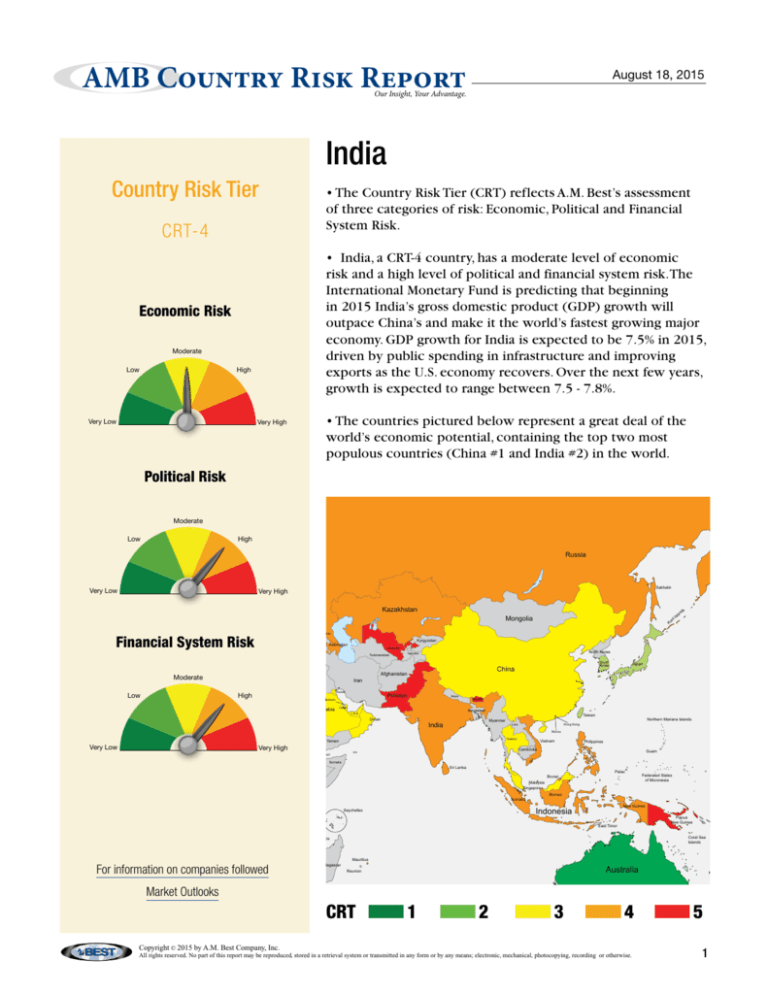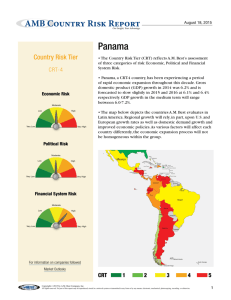
h
a
AMB Country Risk Report
August 18, 2015
Our Insight, Your Advantage.
India
Country Risk Tier
• The Country Risk Tier (CRT) reflects A.M. Best’s assessment
of three categories of risk: Economic, Political and Financial
System Risk.
CRT-4
• India, a CRT-4 country, has a moderate level of economic
risk and a high level of political and financial system risk. The
International Monetary Fund is predicting that beginning
in 2015 India’s gross domestic product (GDP) growth will
outpace China’s and make it the world’s fastest growing major
economy. GDP growth for India is expected to be 7.5% in 2015,
driven by public spending in infrastructure and improving
exports as the U.S. economy recovers. Over the next few years,
growth is expected to range between 7.5 - 7.8%.
Economic Risk
Moderate
Low
High
Very Low
• The countries pictured below represent a great deal of the
world’s economic potential, containing the top two most
populous countries (China #1 and India #2) in the world.
Very High
Political Risk
Iceland
Finland
Greenland
Moderate
Sweden
Norway
Low
High
Estonia
Isle of Man
Ireland
Very Low
Lithuania
Belarus
United
Kingdom
Netherlands
Guernsey
Liechtenstein
Czech
Republic
Austria
Switzerland
France
Ukraine
Slovakia
Luxembourg
Jersey
Bosnia & Serbia
Herzegovina
Bulgaria
Montenegro
Armenia
Albania
Portugal
Gibraltar
Tunisia
Malta
Cyprus
Syria
Lebanon
Moderate
North Korea
Tajikistan
South
Korea
China
Afghanistan
Iraq
Israel
Japan
Iran
Jordan
Low
Kuwait
High
Algeria
Libya
Mauritania
Egypt
Saudi Arabia
Bhutan
Bangladesh
U.A.E.
Myanmar
India
Taiwan
Northern Mariana Islands
Hong Kong
Laos
Wake Island
Macau
Mali
Chad
Niger
Sudan
Very
High
Eritrea
Thailand
Yemen
Vietnam
Philippines
Cambodia
Benin
Nigeria
Ethiopia
Equatorial Guinea
Sao Tome & Principe
Somalia
Sri Lanka
Central Africa Republic
Togo
Brunei
Gabon
Congo
Palau
Malaysia
Singapore
Cameroon
Uganda
Kenya
Sumatra
Rwanda
Dem. Republic
Burundi
of Congo
Seychelles
Tanzania
azil
Malawi
Nauru
New Guinea
Indonesia
Namibia
Market Outlooks
Mauritius
Madagascar
Botswana
Solomon Islands
Reunion
Australia
New Caledonia
Swaziland
Norfolk Island
Lesotho
South Africa
Tuvalu
Vanuatu
Mozambique
For information on companies followed
Papua
New Guinea
Coral Sea
Islands
Comoros
Zambia
Zimbabwe
Federated States
of Micronesia
Borneo
East Timor
Angola
Marshall Islan
Guam
Dijbouti
Burkina Faso
Ghana
Guinea
Sierra
Cote d'Ivoire
Leone
Liberia
Nepal
Qatar
Oman
Senegal
Guinea-Bissau
Pakistan
Bahrain
Western Sahara
Very Low
Gambia
Uzbekistan
Turkmenistan
(Occupied by Morocco)
Cape Verde
s
nd
la
Is
Kyrgyzstan
Azerbaijan
Turkey
Greece
Monaco
Morocco
Georgia
Macedonia
Spain
ril
Ku
Russia
Financial System Risk
Italy
Mongolia
Romania
Croatia
Andorra
Canary
Islands
Kazakhstan
Republic of
Moldova
Hungary
Slovenia
San Marino
Sakhalin
Very High
Poland
Germany
Belgium
Azores
Russia
Russia
Latvia
Denmark
CRT 1 2 3 4 5
Copyright © 2015 by A.M. Best Company, Inc.
All rights reserved. No part of this report may be reproduced, stored in a retrieval system or transmitted in any form or by any means; electronic, mechanical, photocopying, recording or otherwise.
1
New Zealand
F
AMB Country Risk Report
India
Regional Summary: South Central Asia
Vital Statistics 2014
• The region of South Central Asia comprises
the countries south of the Himalayans.
• The outlook for the region over the next
year indicates a modest increase in growth,
largely driven by a stronger export market.
A majority of the region’s economic
output comes from the Indian economy.
• Risks facing the region include
vulnerabilities relating to global economic
conditions including the effects of monetary
policy tightening in the U.S. and the
potential for stagnation in Europe. Domestic
developments, such as political turmoil
and non-sustainable fiscal policies, could
undermine stability and investor confidence.
• As labor costs increase in other Asian
markets, South Central Asia has the
opportunity to increase its manufacturing
activity. However, the region will need
to boost competitiveness by improving
infrastructure, reducing bureaucracy and
limiting corruption.
Nominal GDP
Population
GDP Per Capita
Real GDP Growth
Inflation Rate
Premiums Written (Life)
Premiums Written (Non-Life)
Premiums Growth (2013 - 2014)
USD bn
mil
USD
%
%
USD mil
USD mil
%
2049.50
1259.7
1,627
7.2
6.0
55,299
14,590
7.2
Regional Comparison
Country Risk Tier
CRT-4
CRT-3
CRT-4
CRT-4
CRT-4
CRT-3
India
China
Indonesia
Kazakhstan
Russia
Thailand
Source: IMF, Axco, Swiss Re and A.M. Best
Economic Growth
Economic Risk: Moderate
• India has a diverse economy that is
led by two main industries, the globally
competitive knowledge-driven service
sector and a large agricultural sector, which
employs over 60% of the population.
12
Real GDP
CPI Inflation
10
8
• The lower oil price environment has
been a positive for India as the country
has to import approximately 70% of its
oil requirement. Lower prices will likely
boost domestic demand, and a lower fuel
subsidy bill will benefit India’s external
and fiscal accounts.
• The country has high levels of poverty
with the average GDP per capita at
approximately 1,600 USD in 2014.
%
6
4
2
0
2006
2007
2008
2009
2010
2011
2012
2013
2014
2015
2016
2017
2018
2019
2020
Source: IMF World Economic Outlook and A.M. Best
2
AMB Country Risk Report
India
Political Risk: High
Political Risk Summary
• Prime Minister Modi, of the ruling BJP
party, took office in June of 2014.The BJP
party has a strong mandate in parliament
winning 282 out of 545 seats.The
mandate should help end party paralysis,
allowing important reforms in education,
healthcare and infrastructure to pass.
Score 1 (best) to 5 (worst)
India
World Average
International Transactions
Policy
5
4
Legal System
Monetary Policy
3
2
1
Regional Stability
• The government has recently prioritized
liberalization and approved increased
limits on foreign direct investment
from 26% ownership to 49% ownership
in certain industries, including
telecommunications and insurance.
Fiscal Policy
0
Social Stability
Business Environment
Government Stability
• The country’s most immediate external
threat is with Pakistan and the dispute over
Kashmir.The country also faces potential
domestic threats from terrorism, increasing
levels of violent crimes and periodic social
unrest as a result of income inequality.
Labor Flexibility
Source: A.M. Best
• Specific challenges facing the
government include a high level of
corruption, pervasive bureaucracy, a lack
of transparency, and the need to improve
public safety and reduce levels of poverty.
GDP Per Capita and Population
for Selected Countries
Financial System Risk: High
1600
14,000
GDP Per Capita
Population
1400
12,000
1200
• The insurance industry is regulated
by the Insurance Regulatory and
Development Authority (IRDA).
10,000
1000
USD
Millions
8,000
800
6,000
600
4,000
400
2,000
0
200
India
China
Source: IMF and A.M. Best
Indonesia
Kazakhstan
Russia
Thailand
0
• India’s financial system is well
capitalized and supervised, however,
deteriorating corporate financial positions
and worsening bank asset quality could
weigh on financial sector soundness.
• While gradually improving, further
improvements are needed to enhance
bank supervision and monitoring. Further
strengthening measures needed include
addressing concentration risks, increasing
capital buffers and strengthening the
insolvency framework.
3
AMB Country Risk Report
India
GUIDE TO BEST’S COUnTry rISk TIErS
A.M. Best defines country risk as the risk that country-specific factors could adversely affect the claims-paying ability of an insurer. Country risk is
evaluated and factored into all Best’s Credit Ratings. Countries are placed into one of five tiers, ranging from “CRT-1” (Country Risk Tier 1), denoting
a stable environment with the least amount of risk, to “CRT-5” (Country Risk Tier 5) for countries that pose the most risk and, therefore, the greatest
challenge to an insurer’s financial stability, strength and performance.
A.M. Best’s Country Risk Tiers are not credit ratings and are not directly comparable to a sovereign debt rating, which evaluates the ability and
willingness of a government to service its debt obligations.
Country risk Tiers
Country risk Tier
Definition
CRT-1
Predictable and transparent legal environment, legal system and business infrastructure; sophisticated financial
system regulation with deep capital markets; mature insurance industry framework.
CRT-2
Predictable and transparent legal environment, legal system and business infrastructure; sufficient financial system
regulation; mature insurance industry framework.
CRT-3
Developing legal environment, legal system and business environment with developing capital markets; developing
insurance regulatory structure.
CRT-4
Relatively unpredictable and nontransparent political, legal and business environment with underdeveloped capital
markets; partially to fully inadequate regulatory structure.
CRT-5
Unpredictable and opaque political, legal and business environment with limited or nonexistent capital markets; low
human development and social instability; nascent insurance industry.
Country risk reports
A.M. Best Country Risk Reports are designed to provide a brief, high-level explanation of some of the key factors that determine a country’s Country
Risk Tier assignment. It is not intended to summarize A.M. Best’s opinion on any particular insurance market or the prospects for that market.
Categories of risk
Country Risk Reports provide scores for three categories of risk for each country. These scores are (1) Very Low; (2) Low; (3) Moderate; (4) High
and (5) Very High.
Category of risk
Definition
Economic Risk
The likelihood that fundamental weaknesses in a country’s economy will cause adverse developments for an insurer.
A.M. Best’s assessment of economic risk evaluates the state of the domestic economy, government finances and
international transactions, as well as prospects for growth and stability.
Political Risk
The likelihood that government or bureaucratic inefficiencies, societal tensions, inadequate legal system or
international tensions will cause adverse developments for an insurer. Political risk comprises the stability of the
government and society, the effectiveness of international diplomatic relationships, the reliability and integrity
of the legal system and of the business infrastructure, the efficiency of the government bureaucracy, and the
appropriateness and effectiveness of the government’s economic policies.
Financial System Risk
Financial system risk (which includes both insurance and non-insurance financial system risk) is the risk that financial
volatility may erupt due to inadequate reporting standards, weak banking system or asset markets, and/or poor
regulatory structure. In addition, it includes an evaluation of whether the insurance industry’s level of development and
public awareness, transparent and effective regulation and reporting standards, and sophisticated regulatory body will
contribute to a volatile financial system and compromise the ability of an insurer to pay claims.
Political risk Summary
To provide additional detail on the political risk in a given domicile the Country Risk Reports include the Political Risk Summary. The Political Risk
Summary is a radar chart that displays scores for nine different aspects of political risk scored on a scale of one to five with one being the least
amount of risk and five being the highest amount of risk.
Category
Definition
International Transactions
Policy
Measures the effectiveness of the exchange rate regime and currency management.
Monetary Policy
Measures the ability of a country to effectively implement monetary policy.
Fiscal Policy
Measures the ability of a country to effectively implement fiscal policy.
Business Environment
Measures the overall quality of the business environment and ease of doing business.
Labor Flexibility
Measures the flexibility of the labor market, including the company’s ability to hire and fire employees.
Government Stability
Measures the degree of stability in a government.
Social Stability
Measures the degree of social stability, including human development and political rights.
Regional Stability
Measures the degree of stability in the region.
Legal System
Measures the transparency and level of corruption in the legal system.
Country risk Tier Disclosure
A Country Risk Tier (CRT) is not a credit rating, rather it represents a component of A.M. Best’s Credit Rating Methodology that is applied to all
insurers. A CRT is not a recommendation to purchase, hold or terminate any security, insurance policy, contract or any other financial obligation
issued by a government, an insurer or other rated issuer, nor does it address the suitability of any particular policy, contract or other financial
obligation for a specific purpose or purchaser.
Copyright © 2015 by A.M. Best Company, Inc.
Version 091714
Copyright © 2015 by A.M. Best Company, Inc.
All rights reserved. No part of this report may be reproduced, stored in a retrieval system or transmitted in any form or by any means; electronic, mechanical, photocopying, recording or otherwise.
4












